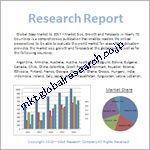目次
第1章.航空宇宙試験の世界市場 エグゼクティブサマリー
1.1.航空宇宙試験の世界市場規模・予測(2022年~2032年)
1.2.地域別概要
1.3.セグメント別概要
1.3.1.検査タイプ別
1.3.2.エンドユーザー別
1.3.3.検査手法別
1.4.主要動向
1.5.景気後退の影響
1.6.アナリストの提言と結論
第2章 航空宇宙試験世界の航空宇宙試験市場の定義と調査前提
2.1.調査目的
2.2.市場の定義
2.3.調査の前提
2.3.1.包含と除外
2.3.2.限界
2.3.3.サプライサイド分析
2.3.4.需要サイド分析
2.4.推計方法
2.5.調査対象年
2.6.通貨換算レート
第3章.航空宇宙試験の世界市場ダイナミクス
3.1.市場促進要因
3.1.1.航空宇宙技術と材料の進歩
3.1.2.厳しい安全基準と規制基準
3.1.3.フリート拡大のためのMRO活動の増加
3.2.市場の課題
3.2.1.高度な検査機器の高コスト
3.2.2.新しい航空宇宙技術の試験における複雑さ
3.3.市場機会
3.3.1.航空宇宙製造における新興市場の成長
3.3.2.持続可能性を重視した試験ソリューションへの需要
第4章.世界の航空宇宙試験市場産業分析
4.1.ポーターのファイブフォースモデル
4.2.PESTEL分析
4.3.主な投資機会
4.4.勝つための戦略
4.5.破壊的トレンド
4.6.アナリストの推奨と結論
第5章 航空宇宙試験航空宇宙試験の世界市場:試験タイプ別市場規模・予測(2022年~2032年)
5.1.セグメントダッシュボード
5.2.収益動向分析
5.2.1.材料試験
5.2.2.環境試験
5.2.3.構造/部品試験
5.2.4.アビオニクス/フライト&エレクトロニクス試験
5.2.5.推進システム試験
第6章 航空宇宙試験航空宇宙試験の世界市場規模・エンドユーザー別予測(2022年~2032年)
6.1.セグメントダッシュボード
6.2.収益動向分析
6.2.1.民間航空
6.2.2.軍事・防衛
6.2.3.宇宙探査
第7章 航空宇宙試験航空宇宙試験の世界市場規模と予測(試験手法別)(2022~2032年
7.1.セグメントダッシュボード
7.2.収益動向分析
7.2.1.インハウステスト
7.2.2.外部委託試験
第8章 航空宇宙試験航空宇宙試験の世界地域別市場規模・予測(2022年~2032年)
8.1.北米
8.1.1.米国
8.1.2.カナダ
8.2.ヨーロッパ
8.2.1.イギリス
8.2.2.ドイツ
8.2.3.フランス
8.2.4.スペイン
8.2.5.イタリア
8.2.6.その他のヨーロッパ
8.3.アジア太平洋
8.3.1.中国
8.3.2.インド
8.3.3.日本
8.3.4.韓国
8.3.5.オーストラリア
8.3.6.その他のアジア太平洋地域
8.4.ラテンアメリカ
8.4.1.ブラジル
8.4.2.メキシコ
8.4.3.その他のラテンアメリカ
8.5.中東・アフリカ
8.5.1.サウジアラビア
8.5.2.南アフリカ
8.5.3.その他の中東・アフリカ
第9章 競争力コンペティティブ・インテリジェンス
9.1.主要企業のSWOT分析
9.1.1.元素材料技術
9.1.2.SGS SA
9.1.3.インターテックグループ
9.2.トップ市場戦略
9.3.企業プロフィール
第10章.調査プロセス
10.1.調査方法
10.2.データマイニング
10.3.バリデーション
10.4.パブリッシング
表一覧
– 表1.世界の航空宇宙試験市場の範囲と定義
– 表2.航空宇宙試験の世界市場 地域別推定・予測(2022-2032年) (百万米ドル/億米ドル)
– 表3.航空宇宙試験の世界市場:試験タイプ別予測・予測(2022-2032年) (百万米ドル/億米ドル)
– 表4.航空宇宙試験の世界市場:エンドユーザー別推定・予測(2022年~2032年) (百万米ドル/億米ドル)
– 表5.航空宇宙試験の世界市場:試験手法別推定・予測(2022-2032年)(百万米ドル/億米ドル)
– 表6.航空宇宙試験市場の世界地域別収益シェア(2023年)
– 表7.北米の航空宇宙試験市場、国別の推定と予測(2022-2032年)
– 表8.欧州の航空宇宙試験市場:国別の見積もりと予測(2022年〜2032年)
– 表9.アジア太平洋地域の航空宇宙試験市場:国別見積もりと予測(2022年〜2032年)
– 表10.中南米の航空宇宙試験市場:国別の見積もりと予測(2022年〜2032年)
– 表11.中東・アフリカの航空宇宙試験市場:国別見積もりと予測(2022年〜2032年)
– 表12.航空宇宙試験市場の成長機会:試験タイプ別(2024年~2032年)
– 表13.航空宇宙試験市場の主要動向と促進要因
– 表14.主要市場プレイヤーのSWOT分析
– 表15.航空宇宙試験システムの技術的進歩(2023年~2032年)
– 表16.航空宇宙試験市場における主な投資機会(2024年~2032年)
– 表17.自社試験サービスとアウトソーシング試験サービスの地域別比較(2023年
– 表18.民間航空宇宙試験:地域別収益内訳(2022年~2032年)
– 表19.航空宇宙試験の世界市場における主要企業:収益分析(2023年
– 表 20.航空宇宙試験市場:持続可能性と排出目標の影響
最終報告書には100以上の表が含まれる。最終報告書には100以上の表が含まれている。
図表リスト
– 図 1.世界の航空宇宙試験市場:調査方法フローチャート
– 図2.航空宇宙試験の世界市場推定手法と予測プロセス
– 図3.航空宇宙試験の世界市場バリューチェーン分析
– 図4.航空宇宙試験の世界市場主要動向の概要(2023年)
– 図 5.航空宇宙試験の世界市場成長予測(2022年~2032年)
– 図6.航空宇宙試験市場のポーターのファイブフォース分析
– 図7.航空宇宙試験市場のPESTEL分析
– 図8.航空宇宙試験市場の世界売上高シェア:試験タイプ別(2023年)
– 図9.航空宇宙検査市場の世界売上高シェア:エンドユーザー別(2023年)
– 図10.航空宇宙試験市場:地域別の成長動向(2022年対2032年)
– 図11.北米の航空宇宙試験市場試験タイプ別収益シェア(2023年)
– 図12.欧州の航空宇宙試験市場試験方法別収益シェア(2023年)
– 図13.アジア太平洋地域の航空宇宙試験市場収益成長予測(2024年~2032年)
– 図14.中南米の航空宇宙試験市場:主要動向と促進要因
– 図15.中東・アフリカの航空宇宙試験市場:持続可能性の影響分析持続可能性への影響分析
– 図16.航空宇宙試験装置の技術的進歩(2023年~2032年)
– 図 17.競争環境:主要企業の売上シェア(2023年)
– 図18.航空宇宙試験主要企業のSWOT分析
– 図 19.航空宇宙試験市場における投資と研究開発の重点(2024年~2032年)
– 図 20.航空宇宙試験における排出量と持続可能性目標の影響
最終報告書には50以上の図表が含まれる。このリストは最終成果物で更新される可能性がある。
Aviation's evolving landscape emphasizes fuel-efficient, low-emission systems, heightening the necessity for extensive testing to align with environmental standards and sustainability objectives. Moreover, the increasing frequency of maintenance, repair, and overhaul (MRO) activities across expanding commercial and defense fleets amplifies the demand for reliable testing solutions. The integration of sophisticated avionics and electronics into next-generation aircraft, alongside emerging technologies such as autonomous flight systems and electric propulsion, underscores the importance of specialized aerospace testing services.
Avionics and flight electronics testing services represent the largest segment, reflecting the critical need for rigorous validation of complex systems operating under varying altitudes, temperatures, and emissions. Meanwhile, the commercial aviation sector dominates as the leading end-user, propelled by rising global air travel and the demand for certified components and systems, including engines, avionics, and airframe structures.
Regional Insights
North America leads the global aerospace testing market, driven by cutting-edge facilities, a robust network of aerospace manufacturers, and significant defense contractor presence. The U.S., home to industry giants like Boeing, Lockheed Martin, and Northrop Grumman, benefits from substantial government support, stringent regulatory mandates, and extensive defense budgets, fostering a favorable environment for aerospace testing advancements.
Major market players included in this report are:
• Element Materials Technology (UK)
• SGS SA (Switzerland)
• Intertek Group plc (UK)
• Applus+ (Spain)
• TÜV SÜD (Germany)
• TÜV Rheinland (Germany)
• TÜV NORD Group (Germany)
• Rohde & Schwarz (Germany)
• Eurofins Scientific (Luxembourg)
• The Boeing Company (US)
• Airbus (Netherlands)
• MISTRAS Group (US)
• Lockheed Martin Corporation (US)
• Bureau Veritas (France)
• DEKRA (Germany)
The detailed segments and sub-segments of the market are explained below:
By Testing Type:
• Material Testing
• Environmental Testing
• Structural/Component Testing
• Avionics/Flight & Electronics Testing
• Propulsion System Testing
By End User:
• Commercial Aviation
• Military & Defense
• Space Exploration
By Testing Approach:
• In-House Testing
• Outsourced Testing
By Region:
North America
• U.S.
• Canada
Europe
• UK
• Germany
• France
• Spain
• Italy
• Rest of Europe
Asia Pacific
• China
• India
• Japan
• South Korea
• Australia
• Rest of Asia Pacific
Latin America
• Brazil
• Mexico
• Rest of Latin America
Middle East & Africa
• Saudi Arabia
• South Africa
• Rest of Middle East & Africa
Years considered for the study are as follows:
Historical year – 2022
Base year – 2023
Forecast period – 2024 to 2032
Key Takeaways:
• Market Estimates & Forecast for 10 years from 2022 to 2032.
• Annualized revenues and regional-level analysis for each market segment.
• Detailed analysis of geographical landscape with country-level analysis of major regions.
• Competitive landscape with information on major players in the market.
• Analysis of key business strategies and recommendations on future market approach.
• Analysis of competitive structure of the market.
• Demand-side and supply-side analysis of the market.
❖ 免責事項 ❖
http://www.globalresearch.jp/disclaimer

